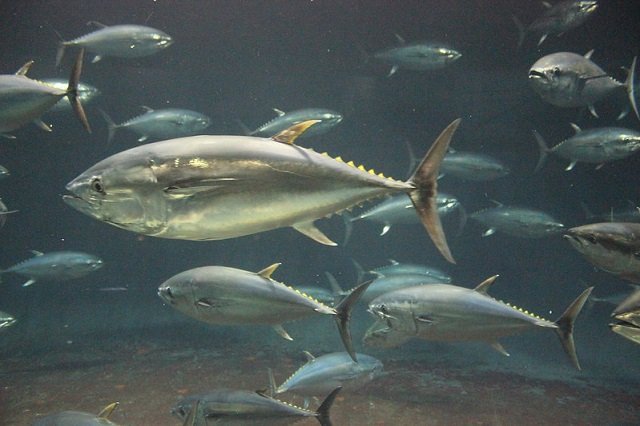
The salmon industry faces the challenge of improving the health and growth of farmed fish while maintaining sustainability. Feed provides nutrients to the fish but must also promote the growth and health of farmed fish.
One promising avenue of research involves using microalgae as functional feed additives. Microalgae, rich in essential nutrients, have been the subject of extensive studies in recent years.
However, when it comes to Atlantic salmon, our knowledge of the effects of microalgae supplementation is still limited.
A study by scientists from Kiel University, the Fraunhofer Research Institution for Individualized and Cell-Based Medical Engineering IMTE, the Max Rubner-Institut, the Fish Genetics Unit, Institute of Genome Biology, Research Institute for Farm Animal Biology (FBN), the University of Rostock, and the University Medical School Schleswig-Holstein aimed to fill this knowledge gap and explore the impact of microalgae-enriched diets on Atlantic salmon raised in recirculating aquaculture systems (RAS).
Microalgae as Feed Additives
Microalgae have gained attention as a sustainable source of ingredients to replace fish meal and oil in aquaculture diets and as functional, prebiotic, and immunostimulant supplements.
The study’s hypothesis was clear: supplementing the feed of Atlantic salmon with 8% microalgae would lead to better performance, higher fatty acid and pigment deposition, and improved health and immunity.
To test this hypothesis, Atlantic salmon smolts were fed five different diets enriched with microalgae, each containing a specific type of microalgae: Tetraselmis chuii (TC), Arthrospira platensis (AP), Schizochytrium limacinum (SL), or Chlorella vulgaris. The Chlorella vulgaris diet was offered both intact (CVI) and as a broken cell wall derivative (CVB). A control group received a standard diet.
Results and Implications
After eight weeks of feeding in brackish water (13 psu), all groups were transferred to seawater (32 psu) for an additional two weeks. The study’s results provided valuable information.
- Improved Feed Conversion and Protein Retention: The CVB diet significantly improved feed conversion and protein retention, indicating its potential to enhance salmon farming efficiency.
- Nutrient Enrichment: Different microalgae diets resulted in different nutrient profiles. Fish fed SL exhibited high levels of docosahexaenoic acid, while alpha-linolenic acid was enriched in fish fed CVI, CVB, and TC.
- Pigment Deposition: Lutein, an essential pigment for salmon, was found in all muscle samples, with the highest concentrations in fish fed CVB, CVI, and TC. This highlights the potential of microalgae diets to enhance the visual appeal of salmon fillets.
- Immune and Health Responses: Microalgae supplementation triggered various changes in gene expression in the anterior intestine and liver. For example, CVI and SL diets induced the expression of complement C1q like 2 (c1ql2) in the liver, while reducing the expression of serum amyloid A5 (saa5). These changes indicate a better immune and health response in fish.
- No Negative Impact on Growth: Perhaps most importantly, the study demonstrated that the use of microalgae as feed additives did not negatively affect the growth of Atlantic salmon raised in RAS.
Potential Use of Microalgae in Aquaculture Feeds
According to the study, the future use of microalgae as a functional feed ingredient depends on production costs and economic benefits when incorporated into Atlantic salmon diets.
Stay Always Informed
Join our communities to instantly receive the most important news, reports, and analysis from the aquaculture industry.
“While we investigated microalgae that are already commercially cultured, the current price (between 20 and 30 euros per kg) allows for their use at higher inclusion levels only for restricted periods of time,” the researchers report.
They also note that improving product quality before slaughter by increasing the content of DHA and carotenoids in fillets, with known benefits for human health, may represent an economically viable strategy that needs further exploration.
Conclusion
The findings of this study are very promising for the salmon industry. Commercially relevant microalgae can be leveraged as functional feed additives to improve the health, nutrient content, and visual appeal of Atlantic salmon without compromising growth performance.
“We confirmed the transfer of important functional components of microalgae (polyunsaturated fatty acids and pigments) to fish muscle, but the role and function of many of the functional compounds present in microalgae remain difficult to reach and require further research,” the researchers conclude.
The study was funded by BMBF as part of the BioFiA project and the AQUATOR project. In addition, the researchers received funding from the State of Schleswig-Holstein under the Open Access Publikationsfonds financing program.
Contact
Jonas Mueller
Department for Marine Aquaculture
Institute of Animal Breeding and Husbandry
Kiel University, Kiel, Germany
Email:jmueller@tierzucht.uni-kiel.de
Reference (open access)
Mueller J, Pauly M, Molkentin J, Ostermeyer U, van Muilekom DR, Rebl A, Goldammer T, Lindemeyer J, Schultheiß T, Seibel H and Schulz C (2023) Microalgae as functional feed for Atlantic salmon: effects on growth, health, immunity, muscle fatty acid and pigment deposition. Front. Mar. Sci. 10:1273614. doi: 10.3389/fmars.2023.1273614
Editor at the digital magazine AquaHoy. He holds a degree in Aquaculture Biology from the National University of Santa (UNS) and a Master’s degree in Science and Innovation Management from the Polytechnic University of Valencia, with postgraduate diplomas in Business Innovation and Innovation Management. He possesses extensive experience in the aquaculture and fisheries sector, having led the Fisheries Innovation Unit of the National Program for Innovation in Fisheries and Aquaculture (PNIPA). He has served as a senior consultant in technology watch, an innovation project formulator and advisor, and a lecturer at UNS. He is a member of the Peruvian College of Biologists and was recognized by the World Aquaculture Society (WAS) in 2016 for his contribution to aquaculture.




